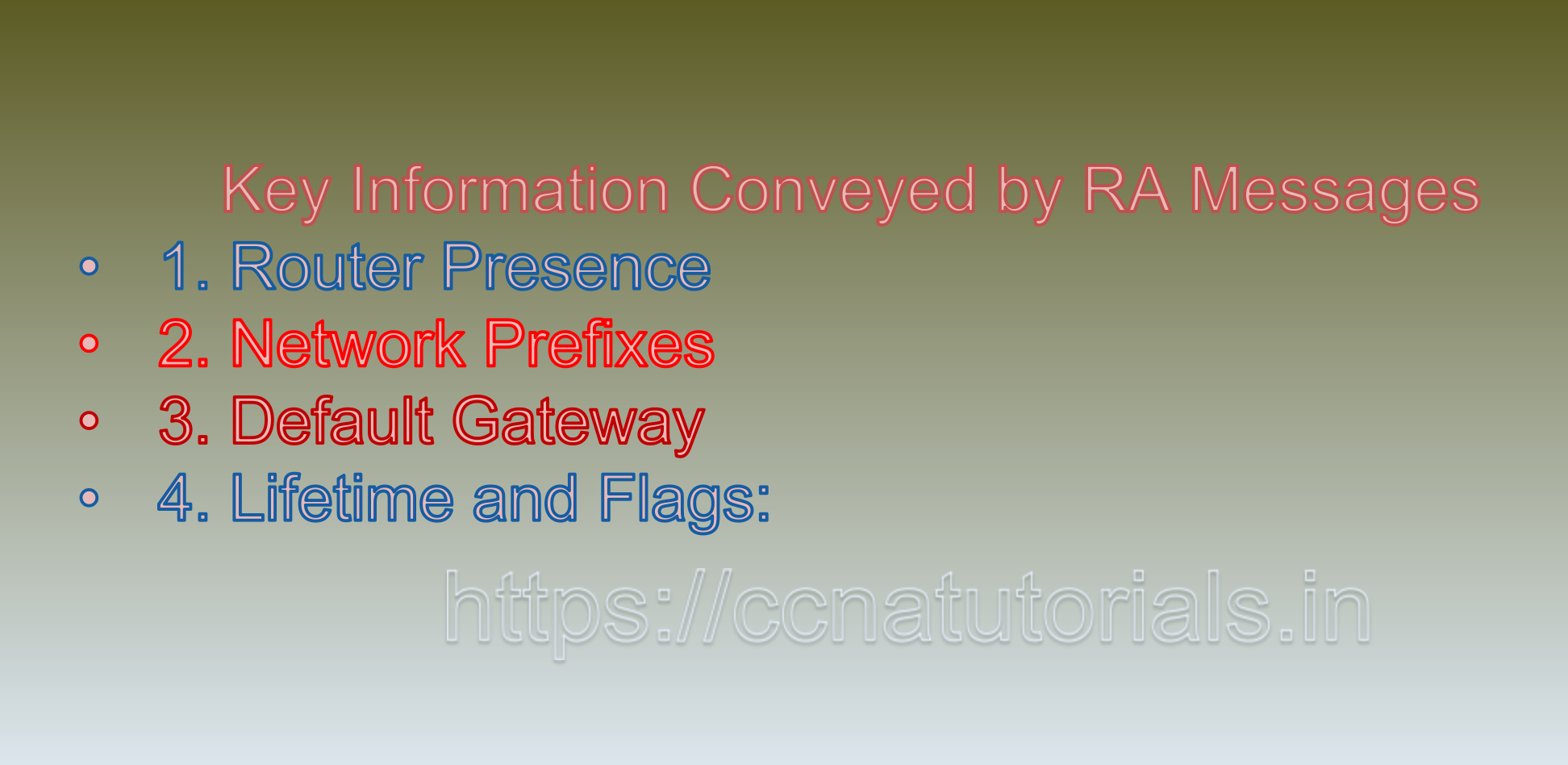Contents of this article
In this article, I describe IPv6 Router Advertisement Messages: Guiding the Path in Next-Generation Networks in IPv6. In the realm of IPv6 networking, Router Advertisement messages serve as essential beacons that guide devices through the vast expanse of the digital landscape. As a key component of the Neighbor Discovery Protocol (NDP), RA messages play a pivotal role in network configuration, providing devices with crucial information about routers, prefixes, and network parameters. In this comprehensive exploration, we delve into the intricacies of IPv6 Router Advertisement messages, uncovering their purpose, structure, and significance in shaping the connectivity and efficiency of modern networks.
The Essence of IPv6 Router Advertisement Messages:
IPv6 Router Advertisement messages are essential communication units that routers periodically transmit onto the local network. Their primary function is to inform neighboring devices about the presence of routers and provide essential configuration details that enable devices to effectively communicate and route data within the network.
Key Information Conveyed by RA Messages:
RA messages convey a wealth of information that empowers devices to configure themselves and make informed decisions about routing and communication. Here are the key pieces of information conveyed by RA messages:
1. Router Presence:
RA messages indicate the presence of routers on the network, allowing devices to recognize and interact with routers for efficient data transmission.
2. Network Prefixes:
RA messages contain information about network prefixes, which enable devices to generate their own unique IPv6 addresses and communicate within the network.
3. Default Gateway:
Routers provide details about the default gateway, which is crucial for routing packets destined for external networks.
4. Lifetime and Flags:
RA messages include parameters such as the lifetime of the information provided and flags that indicate specific network characteristics.
RA Message Structure:
IPv6 Router Advertisement messages follow a structured format to convey the necessary information to neighboring devices. Here’s an overview of the key components of an RA message:
– Type (1 byte): Indicates that the message is a Router Advertisement (Type 134).
– Code (1 byte): Always set to 0.
– Checksum (2 bytes): Provides error-checking for the message.
– Cur Hop Limit (1 byte): Specifies the default hop limit for outgoing packets.
– M (1 bit) and O (1 bit) Flags: The M flag indicates whether the router is providing Prefix Information, while the O flag indicates whether other configuration information is available.
– Router Lifetime (2 bytes): Specifies the time in seconds for which the router is considered reachable.
– Reachable Time (4 bytes): Represents the base time (in milliseconds) that a node considers a router to be reachable.
– Retrans Timer (4 bytes): Specifies the time (in milliseconds) that a node waits before retransmitting Neighbor Solicitation messages.
– Options: The options field contains various options that provide additional information, including Prefix Information, MTU, and more.
Practical Applications of IPv6 Router Advertisement Messages:
IPv6 Router Advertisement messages play a pivotal role in shaping network behavior and functionality. Let’s explore a few practical applications of RA messages:
1. Address Autoconfiguration:
Devices use Prefix Information from RA messages to automatically generate their own IPv6 addresses, streamlining the process of joining a network.
2. Network Prefix Updates:
RA messages allow routers to inform devices about changes in network prefixes, ensuring that devices have up-to-date information for communication.
3. Optimal Routing:
RA messages guide devices to choose the most suitable default gateway for external communication, optimizing routing paths and enhancing data transmission efficiency.
4. Link-Layer Address Resolution:
Devices use RA messages to resolve the link-layer (MAC) address of the router, facilitating seamless communication between devices and routers.
Example Scenario:
Consider a scenario where a new device joins a Wi-Fi network. As the device connects, it listens for RA messages from routers on the network. Upon receiving an RA message, the device extracts essential information, including network prefixes and the default gateway. It then configures its own IPv6 address using the provided prefix, ensuring compatibility and effective communication within the network. Additionally, the device learns about the router’s reachability and updates its routing table, allowing it to efficiently route packets to external destinations.
Security and Considerations:
While IPv6 Router Advertisement messages provide critical network configuration information, they can also be potential targets for malicious activities. Unauthorized RA messages can disrupt network operations or mislead devices. Implementing security measures such as Router Advertisement Guard (RA-Guard) can help mitigate these risks and ensure the authenticity of RA messages.
Conclusion IPv6 Router Advertisement messages:
IPv6 Router Advertisement messages stand as guiding lights in the intricate landscape of modern networking. Through their structured format and vital information, these messages enable devices to configure themselves, communicate effectively, and navigate the complexities of routing within IPv6 networks. RA messages play an instrumental role in addressing the challenges and opportunities presented by the digital age, ensuring that devices traverse the network terrain with precision, efficiency, and connectivity. As networking technologies continue to evolve, the importance of IPv6 Router Advertisement messages remains steadfast, shaping the way devices establish connections, transmit data, and explore the boundless horizons of the digital world.

IPv6 Router Advertisement Messages: Illuminating the Path to Network Configuration
IPv6 Router Advertisement messages are vital components of the Neighbor Discovery Protocol (NDP) that play a pivotal role in guiding devices through network configuration. These messages are broadcast by routers to inform neighboring devices about network parameters, prefixes, and default gateways. In this illustrative guide, we’ll explore the essence of IPv6 Router Advertisement messages through real-world examples, shedding light on their structure, purpose, and practical applications.
Example 1: Network Prefix and Address Autoconfiguration
Suppose a network administrator sets up an IPv6 network with the prefix `2001:db8:1234::/64`. Routers on the network periodically send Router Advertisement messages to inform devices about this prefix. Consider a host device that listens to these messages:
plaintext
Router Advertisement (RA):
– Prefix Information: 2001:db8:1234::/64
– Default Gateway: Link-Local Address of Router
– Router Lifetime: 1800 seconds
– Flags: M (Managed), O (Other Configuration)
Upon receiving the RA message, the host device gains essential information for configuration:
– Prefix: The host device uses the received prefix (`2001:db8:1234::/64`) to automatically configure its own IPv6 address (`2001:db8:1234::XYZ`) using Stateless Address Autoconfiguration (SLAAC).
– Default Gateway: The host device identifies the router as the default gateway for external communication.
Example 2: Redundant Routers and Default Gateway Selection
In a larger network, multiple routers might exist to ensure redundancy and load balancing. Routers can signal their presence through RA messages, allowing devices to select the most appropriate default gateway. Consider a network with two routers:
plaintext
Router Advertisement (RA) from Router A:
– Prefix Information: 2001:db8:abcd::/64
– Default Gateway: Link-Local Address of Router A
– Router Lifetime: 3600 seconds
– Flags: M (Managed), O (Other Configuration)
Router Advertisement (RA) from Router B:
– Prefix Information: 2001:db8:abcd::/64
– Default Gateway: Link-Local Address of Router B
– Router Lifetime: 3600 seconds
– Flags: M (Managed), O (Other Configuration)
Devices on the network receive RA messages from both Router A and Router B. They now have the flexibility to choose either router as their default gateway based on various factors such as router health, load, or connectivity.
Example 3: MTU Discovery and Path Optimization
RA messages also facilitate Path Maximum Transmission Unit (MTU) discovery, which helps devices determine the maximum packet size that can be transmitted across the network. A lower MTU can lead to fragmentation and performance issues.
Consider an RA message with MTU information:
plaintext
Router Advertisement (RA):
– Prefix Information: 2001:db8:abcd::/64
– Default Gateway: Link-Local Address of Router
– MTU: 1500 bytes
– Router Lifetime: 1800 seconds
– Flags: M (Managed), O (Other Configuration)
Devices receive the MTU value and adjust their packet sizes accordingly. This helps prevent fragmentation and ensures optimal data transmission efficiency.
Example 4: Recursive DNS Server Configuration
RA messages can also include information about Recursive DNS (Domain Name System) servers, which assist devices in resolving domain names to IP addresses. Consider an RA message that provides DNS server information:
plaintext
Router Advertisement (RA):
– Prefix Information: 2001:db8:abcd::/64
– Default Gateway: Link-Local Address of Router
– DNS Servers: 2001:db8:1::1, 2001:db8:1::2
– Router Lifetime: 1800 seconds
– Flags: M (Managed), O (Other Configuration)
Devices receive the DNS server addresses and can use them for domain name resolution, enhancing the overall browsing experience.
Security and Considerations:
While IPv6 Router Advertisement messages provide essential configuration information, they can also be targets for attacks if not properly secured. Implementing features like Router Advertisement Guard (RA-Guard) can help prevent unauthorized or malicious RA messages from disrupting the network.
Summary: Guiding Network Configuration Through IPv6 Router Advertisement messages:
IPv6 Router Advertisement messages serve as guiding lights in the intricate landscape of networking, providing devices with vital information for network configuration and optimization. From network prefixes and default gateways to MTU values and DNS server addresses, RA messages enable seamless communication and efficient data transmission. As networking technologies evolve, the role of RA messages remains steadfast, ensuring that devices navigate the complexities of the digital realm with precision, connectivity, and enhanced user experiences.






